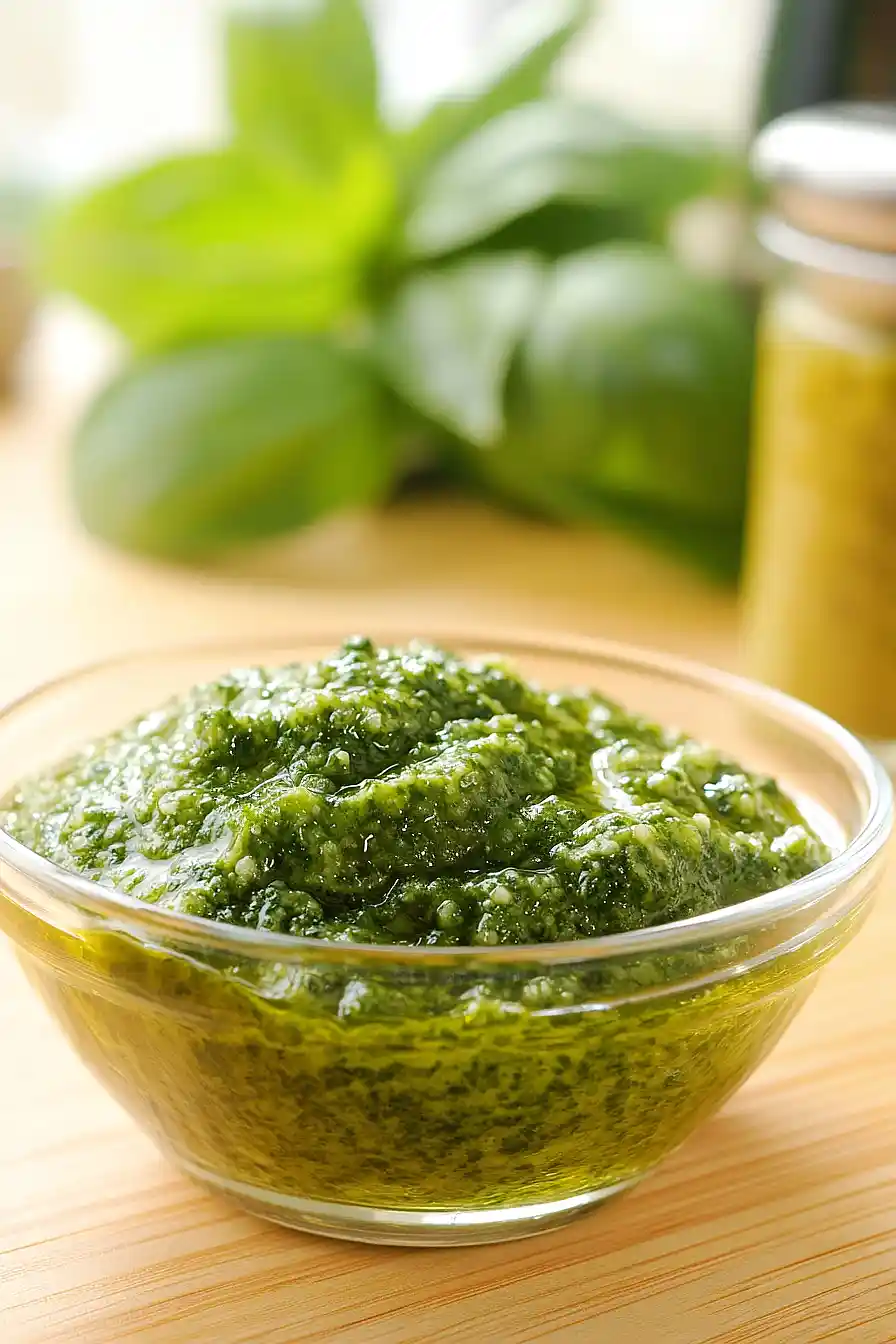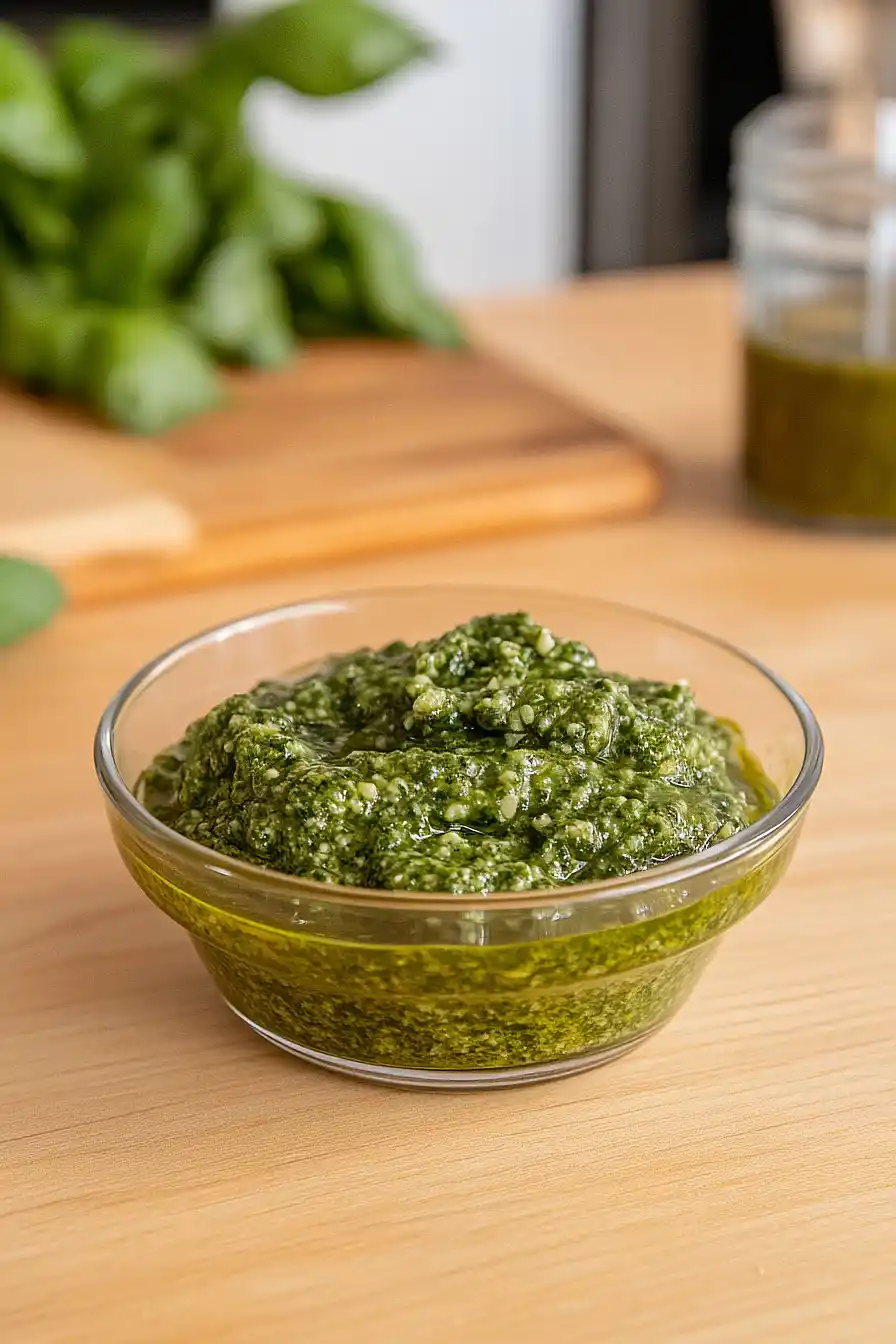Making fresh pesto from scratch might seem like a task best left to Italian grandmothers or fancy restaurants, but here’s the thing – it’s actually one of the easiest and most rewarding sauces you can whip up at home. Between juggling work deadlines and family dinners, I’ve found that having a reliable pesto recipe in my back pocket saves countless meals when time is tight.
This classic pesto genovese recipe is straightforward and forgiving, using just a handful of fresh ingredients that come together in minutes. Plus, it’s the kind of sauce that makes everything taste better, from a simple pasta dish to a quick sandwich spread.

Why You’ll Love This Pesto
- Quick preparation – This classic pesto comes together in just 10 minutes – perfect for those busy weeknights when you need a quick sauce for pasta or sandwiches.
- Fresh ingredients – Made with fresh basil leaves and real Italian cheeses, this sauce brings authentic Italian flavor right to your kitchen.
- Versatile sauce – You can use it on pasta, spread it on sandwiches, mix it into soups, or dollop it on pizza – the possibilities are endless.
- Simple recipe – With just 6 basic ingredients and a food processor, you can make restaurant-quality pesto at home that’s better than store-bought.
- Make-ahead friendly – This pesto keeps well in the fridge and can be frozen in portions, so you can always have fresh-tasting sauce on hand.
What Kind of Basil Should I Use?
For authentic pesto Genovese, you’ll want to use sweet basil (also called Genovese basil), which has bright green leaves and a classic sweet-spicy aroma. The leaves should be fresh and young – larger, older leaves can taste bitter and throw off the balance of your pesto. If you’re growing your own, try to harvest the leaves in the morning when the essential oils are most concentrated. While you might be tempted to substitute other varieties like Thai basil or purple basil, these will give you a noticeably different flavor than the traditional sweet basil that makes pesto Genovese so special. When picking or buying basil, look for leaves that are bright green without any dark spots or yellowing, and avoid any that look wilted or bruised.

Options for Substitutions
While traditional pesto genovese has specific ingredients, here are some practical substitutions if you need them:
- Fresh basil: This is the star ingredient that really shouldn’t be substituted in a true pesto genovese. Fresh basil gives this sauce its classic taste and bright green color. Dried basil won’t work here.
- Pine nuts: Pine nuts can be expensive, so feel free to swap them with walnuts, almonds, or even sunflower seeds. Just make sure to toast them first for the best flavor. For nut allergies, you can use pumpkin seeds.
- Parmigiano-Reggiano: If you can’t find Parmigiano-Reggiano, regular parmesan cheese works fine. In a pinch, you could use all Pecorino Romano, but the flavor will be sharper and saltier.
- Extra virgin olive oil: Stick with extra virgin olive oil here – it’s a key flavor component. Other oils won’t give you the same Mediterranean taste that makes pesto special.
- Garlic: Fresh garlic is best, but if you’re in a rush, you can use pre-minced garlic – about 1 teaspoon equals 2 cloves. Just avoid garlic powder for this fresh sauce.
Watch Out for These Mistakes While Making
The biggest mistake when making pesto is overprocessing the ingredients, which can turn your bright basil sauce into a dark, bitter paste – use short pulses in your food processor and stop as soon as the ingredients are combined but still have some texture.
Temperature matters more than you might think: heat is pesto’s enemy, so avoid using warm ingredients or a hot food processor bowl, and never process longer than necessary as the friction can heat up and discolor your sauce.
A common error is adding too much garlic right away – start with less than you think you need and adjust to taste, as raw garlic can quickly overpower the delicate basil flavor.
For the best flavor and texture, toast your pine nuts until lightly golden before adding them to the mix, and remember to add the olive oil gradually in a steady stream while processing, rather than all at once, which helps create the perfect emulsion.

What to Serve With Pesto?
While pasta is the most common pairing for pesto (and for good reason!), this fresh sauce can do so much more in the kitchen. Try spreading it on crusty Italian bread for a quick appetizer, or use it as a sauce for grilled chicken or fish – it’s especially good with salmon. I love mixing a spoonful into scrambled eggs for breakfast or spreading it on a sandwich instead of mayo. For a light summer meal, toss it with some roasted cherry tomatoes and fresh mozzarella balls, or use it as a pizza sauce instead of traditional tomato sauce. The garlicky, herby flavors work well with pretty much anything!
Storage Instructions
Keep Fresh: Your homemade pesto will stay fresh in the fridge for about 5-7 days when stored in an airtight container. Pro tip: pour a thin layer of olive oil on top of the pesto before closing the container – this helps prevent the basil from oxidizing and turning brown.
Freeze: Pesto is perfect for freezing! Pour it into ice cube trays, freeze until solid, then transfer the cubes to a freezer bag. They’ll keep for up to 6 months, and you can pop out just what you need for your recipes. I like to make a big batch in summer when basil is plentiful and freeze it for winter months.
Prep Ahead: Want to get ahead? You can toast the pine nuts and grate the cheese in advance, storing them separately until you’re ready to make the pesto. Just wait to process the basil until you’re ready to use it – this ensures the freshest flavor and that gorgeous green color.
| Preparation Time | 10-15 minutes |
| Cooking Time | 0-0 minutes |
| Total Time | 10-15 minutes |
| Level of Difficulty | Medium |
Estimated Nutrition
Estimated nutrition for the whole recipe (without optional ingredients):
- Calories: 1200-1400
- Protein: 25-30 g
- Fat: 130-150 g
- Carbohydrates: 15-20 g
Ingredients
- 2 garlic cloves (peeled and smashed)
- 2 tbsp pine nuts (lightly toasted for deeper flavor)
- 1/2 cup extra virgin olive oil (like Bertolli, for a classic flavor)
- 1 1/2 tbsp grated Pecorino Romano cheese
- 1 bunch fresh basil leaves
- 1/2 cup grated Parmigiano-Reggiano cheese
Step 1: Prepare Garlic and Pine Nuts
Start by crushing garlic cloves using a mortar and pestle until they are finely mashed.
Add pine nuts to the mortar and crush them together with the garlic.
Continue crushing until the mixture is well blended and forms a consistent texture.
Step 2: Incorporate Basil Leaves
Gradually add fresh basil leaves to the garlic and pine nut mixture in the mortar.
Use circular movements with the pestle to crush the basil leaves, working them into the mixture.
Keep mixing and crushing until a smooth, fragrant paste forms.
Step 3: Add Cheeses
Transfer the basil paste to a mixing bowl.
Using a wooden spoon, mix in Parmigiano-Reggiano cheese and pecorino Romano cheese.
Stir thoroughly to integrate the cheeses into the basil paste.
Step 4: Blend with Olive Oil
Slowly drizzle olive oil into the cheese and basil mixture, stirring continuously.
Continue to stir until the olive oil is fully incorporated and the pesto is evenly blended.
The result should be a smooth, creamy pesto sauce ready to enhance your favorite dishes.

